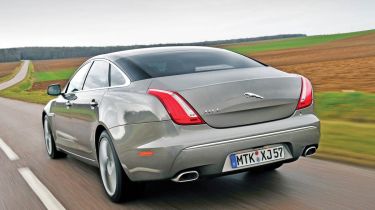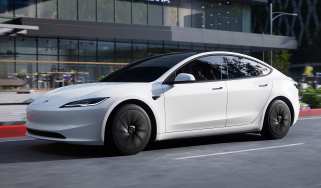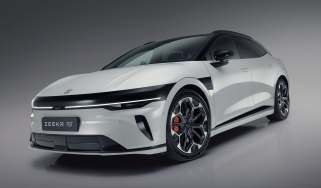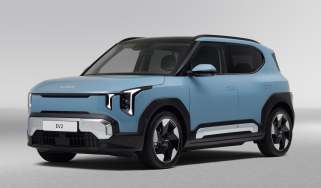Jaguar XJL 3.0D
Tradition of previous model has been replaced with sporty, hi-tech edge
If you want to stand out from the luxury car crowd, this is how to do it. The new XJ is the only model in this class capable of attracting the kind of attention usually reserved for supercars.
That’s partly down to the novelty value of seeing one in the metal, but there’s no getting away from its striking front end and sleek profile. The Jag is lower than its rivals, and its sloping roofline and 20-inch alloys give it presence. Only from the back does the newcomer struggle. The gloss black C-pillar trims are a clumsy and unconvincing attempt to make the saloon look as if it has a wraparound rear windscreen.
Video: watch CarBuyer's video review of the Jaguar XJ
[[{"type":"media","view_mode":"content_narrow","fid":"68507","attributes":{"alt":"","class":"media-image"}}]]
The cabin is just as extrovert as the exterior. With wood trim, a leather dashboard and lots of chrome, the XJ couldn’t be more British. But if the eyeball air vents conjure up images of Jaguars past, the virtual instruments are at the cutting edge of technology.
Instead of traditional analogue dials, the Jaguar features a screen with a computer-generated rev counter, speedometer and fuel gauge. Flexibility is what makes this so clever. For example, warning messages flash up in place of the rev counter and sat-nav directions appear in the window usually occupied by the fuel gauge. Select Dynamic Mode, and the dials gain a purposeful red tint and a scrolling gear indicator.
Used - available now

2021 Vauxhall
Mokka
12,860 milesAutomaticPetrol1.2L
Cash £16,235
2023 Hyundai
Tucson
33,877 milesAutomaticPetrol1.6L
Cash £22,200
2023 Hyundai
Tucson
15,669 milesAutomaticPetrol1.6L
Cash £23,197
2023 MINI
Cooper Electric
20,538 milesAutomaticElectric
Cash £15,497The overall impression is of undisputed luxury, and the sense of occasion is far greater than in either German car. Sit in the back, though, and there’s a price to pay for the XJ’s sleek profile. There’s less headroom than in either rival, and six-footers will find their hair brushing against the rooflining.
Rear visibility is also affected by the car’s narrow windows and high waistline, while the level of fit and finish inside is good rather than exceptional.
The Jaguar does lead the way for performance, though. Its 3.0-litre V6 diesel has 271bhp, which gives the XJ an advantage in this test. A torque output of 600Nm is 60Nm up on both the German cars, and this produced predictable results against the clock. The Jaguar covered 0-60mph in 6.6 seconds – one-tenth faster than the BMW and Mercedes.
In reality there is little to split the cars on the road. They all deliver impressive overtaking punch and smooth-shifting auto boxes, but the way they go about deploying their performance is where the differences lie.
Jaguar has given the new XJ a sporty character. The low-slung driving position and snug cabin deliver this sensation even at a standstill, yet it increases when you hit the road. The car’s agility is truly impressive. Even in long-wheelbase guise, it feels like a sporty exec saloon rather than a full-bore luxury model. Dynamic Mode sharpens the responses even further, although the differences are barely perceptible.
However, the light steering lacks the weight of the 5.0-litre petrol V8 model’s, and it takes time to get used to its responsive set-up.
The trade-off for the XJ’s agility becomes apparent when the road surface deteriorates. On smooth tarmac the Jag rides beautifully, but encounter a bump, and it doesn’t cope as well as the S-Class. While passengers are isolated from small imperfections in the Merc, they’re all too obvious in the XJ.
We have to comment on the Jag’s brakes. Aided by the saloon’s lightweight aluminium construction, they generate huge stopping power and bring the XJ to a halt from 70mph in a sports car-like 41.9 metres. But over bumpy tarmac, the firmer suspension made the Jaguar less effective – adding more than 10 metres to that figure. In contrast, the discrepancy for the more supple BMW was only a couple of metres from surface to surface.
While the Jaguar is an enjoyable car to drive, it’s less refined, comfortable and spacious than its rivals here. That could prove costly in the rarefied atmosphere of the luxury saloon car market.
Details
Chart position: 2
WHY: The XJ has been thoroughly reinvented – but it faces some of the most talented machinery in the entire car industry.



